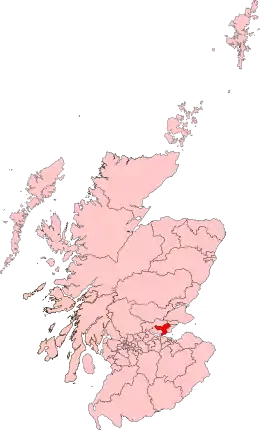Dunfermline East (UK Parliament constituency)
Dunfermline East was a burgh constituency represented in the House of Commons of the Parliament of the United Kingdom. It elected one Member of Parliament (MP) by the first-past-the-post voting system.
| Dunfermline East | |
|---|---|
| Former Burgh constituency for the House of Commons | |
 Boundary of Dunfermline East in Scotland for the 2001 general election | |
| Major settlements | Cowdenbeath |
| 1983–2005 | |
| Seats | One |
| Created from | Central Fife Dunfermline |
| Replaced by | Kirkcaldy & Cowdenbeath Dunfermline & West Fife Glenrothes |
The constituency was created for the 1983 general election from parts of the seats of Central Fife and Dunfermline. It was abolished for the 2005 general election as part of a major revision in the composition of parliamentary constituencies in Scotland.
Most of Dunfermline East and its neighbouring constituency Kirkcaldy now make up the new seat of Kirkcaldy and Cowdenbeath. The remaining parts of the seat were moved to the new Dunfermline and West Fife and Glenrothes constituencies.
The constituency's name was something of a misnomer as it never actually included any part of the town of Dunfermline, all of which was located in the Dunfermline West seat. Cowdenbeath was the largest town in the constituency.
Boundaries
1983–1997: The Dunfermline District electoral divisions of Aberdour/Dalgety Bay/North Queensferry, Ballingry/Lochore, Cowdenbeath/Gray Park, Dunfermline/Rosyth, Hill of Beath/Crossgates/Cowdenbeath, Inverkeithing/Rosyth, Kelty/Lumphinnans, and Lochgelly, and the Kirkcaldy District electoral division of Auchterderran.
1997–2005: The Dunfermline District electoral divisions of Aberdour and Mossside, Benarty and Lumphinans, Cowdenbeath, Dalgety Bay, Inverkeithing and North Queensferry, Kelty, Lochgelly, and Rosyth East and South, and the Kirkcaldy District electoral division of Cardenden and Kinglassie.
Members of Parliament
The constituency's only MP was Gordon Brown of the Labour Party, who was Shadow Chancellor of the Exchequer from 1992 to 1997 and Chancellor of the Exchequer from 1997 to 2007, when he became Prime Minister.
| Election | Member[1] | Party | |
|---|---|---|---|
| 1983 | Gordon Brown | Labour | |
Election results
Elections in the 1980s
| Party | Candidate | Votes | % | ±% | |
|---|---|---|---|---|---|
| Labour | Gordon Brown | 18,515 | 51.5 | -10.5 | |
| Liberal | David Harcus | 7,214 | 20.1 | ||
| Conservative | Clive Shenton | 6,764 | 18.8 | -2.8 | |
| SNP | George Hunter | 2,573 | 7.2 | -6.8 | |
| Communist | Alex Maxwell | 864 | 2.4 | ||
| Majority | 11,301 | 31.4 | |||
| Turnout | 35,930 | 72.0 | |||
| Labour win (new seat) | |||||
| Party | Candidate | Votes | % | ±% | |
|---|---|---|---|---|---|
| Labour | Gordon Brown | 25,381 | 64.5 | +13.0 | |
| Conservative | Clive Shenton | 5,792 | 14.8 | −4.0 | |
| Liberal | Elizabeth Harris | 4,122 | 10.5 | −9.6 | |
| SNP | Alice McGarry | 3,901 | 10.0 | +2.8 | |
| Majority | 19,589 | 49.7 | +18.3 | ||
| Turnout | 39,196 | 76.6 | +4.6 | ||
| Labour hold | Swing | +8.5 | |||
Elections in the 1990s
| Party | Candidate | Votes | % | ±% | |
|---|---|---|---|---|---|
| Labour | Gordon Brown | 23,692 | 62.4 | −2.1 | |
| Conservative | Mark E. Tennant | 6,248 | 16.5 | +1.7 | |
| SNP | John V. Lloyd | 5,746 | 15.1 | +5.1 | |
| Liberal Democrats | Teresa Martin Little | 2,262 | 6.0 | −4.5 | |
| Majority | 17,444 | 45.9 | -3.8 | ||
| Turnout | 37,948 | 75.6 | −1.0 | ||
| Labour hold | Swing | −2.4 | |||
| Party | Candidate | Votes | % | ±% | |
|---|---|---|---|---|---|
| Labour | Gordon Brown | 24,441 | 66.8 | +4.4 | |
| SNP | John James Ramage | 5,690 | 15.6 | +0.5 | |
| Conservative | Iain Grant Mitchell | 3,656 | 10.0 | −6.5 | |
| Liberal Democrats | Jim Tolson | 2,164 | 5.9 | −0.1 | |
| Referendum | Thomas Dunsmore | 632 | 1.7 | New | |
| Majority | 18,751 | 51.2 | +6.3 | ||
| Turnout | 36,583 | 69.6 | −7.0 | ||
| Labour hold | Swing | +2.5 | |||
Elections in the 2000s
| Party | Candidate | Votes | % | ±% | |
|---|---|---|---|---|---|
| Labour | Gordon Brown | 19,487 | 64.8 | −2.0 | |
| SNP | Johnny Joseph James Mellon | 4,424 | 14.7 | −0.9 | |
| Conservative | Stuart Roy Randall | 2,838 | 9.4 | −0.6 | |
| Liberal Democrats | John Maciver Mainland | 2,281 | 7.6 | +1.7 | |
| Scottish Socialist | Andrew Jackson | 770 | 2.6 | New | |
| UKIP | Thomas Dunsmore | 286 | 1.0 | New | |
| Majority | 15,063 | 50.1 | -1.1 | ||
| Turnout | 30,086 | 57.0 | −12.6 | ||
| Labour hold | Swing | -1.4 | |||
References
- Leigh Rayment's Historical List of MPs – Constituencies beginning with "D" (part 4)
- "Election Data 1983". Electoral Calculus. Archived from the original on 15 October 2011. Retrieved 18 October 2015.
- "Election Data 1987". Electoral Calculus. Archived from the original on 15 October 2011. Retrieved 18 October 2015.
- "Election Data 1992". Electoral Calculus. Archived from the original on 15 October 2011. Retrieved 18 October 2015.
- "Election Data 1997". Electoral Calculus. Archived from the original on 15 October 2011. Retrieved 18 October 2015.
- "Election Data 2001". Electoral Calculus. Archived from the original on 15 October 2011. Retrieved 18 October 2015.